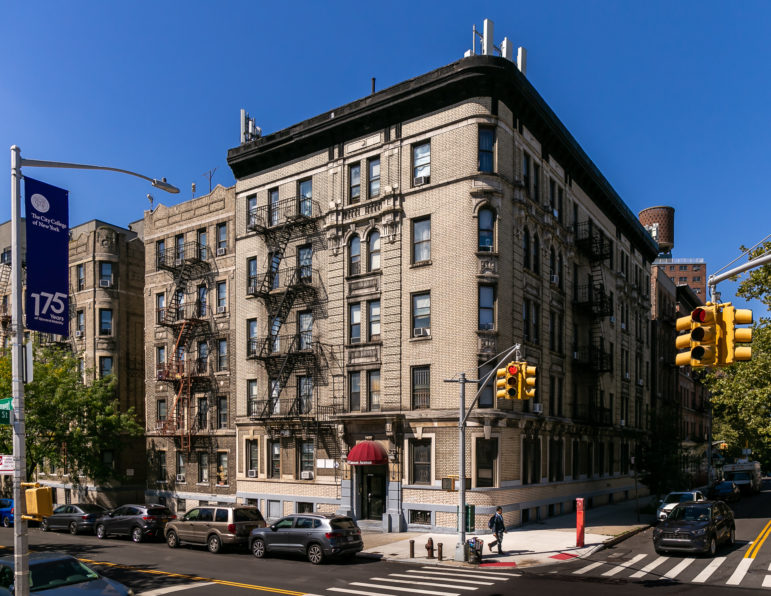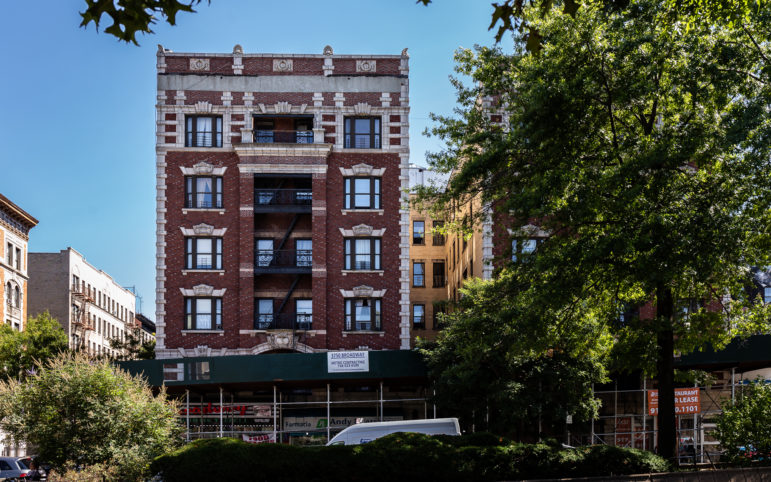A state judge granted class certification to past and present tenants in 11 buildings who have sued their landlord for “systemic evasion of the rent regulations” in a case that attorneys say could set a precedent for future actions.

Adi Talwar
Tenants at 110 Convent Ave. in Harlem are part of a class action lawsuit claiming their landlord fraudulently raised their rents in stabilized apartments.Hundreds of tenants across 11 Harlem buildings can now band together to challenge a landlord accused of illegally hiking rents in their stabilized apartments after a state judge approved their unique class action lawsuit last month.
The tenants say the landlord, a collection of single-entity LLCs tied to the firms Big City Properties and Magnolia Holdings, inflated rents by making phony individual apartment improvement claims, failing to register units with the state and withholding stabilized leases despite receiving city tax breaks. Following an investigation by the housing watchdog group Housing Rights Initiative (HRI), residents sued the landlord in 2016 and, after a series of court challenges, won an appeal paving the way for the class action case in 2019.
Manhattan Supreme Court Justice Sabrina Kraus formally certified the class on Aug. 15, writing that the landlords are accused of “systemic evasion of the rent regulations” and that tenants showed in great detail a “methodical attempt to illegally inflate rents and evade the requirements of rent-stabilization.”
She ordered the landlords to provide the tenants’ attorneys, from the firm Newman Ferrara, with current rent rolls, as well as information about former residents dating back to December 2012 so they can be added to the case. Attorney Roger Sachar said the class could include around 2,000 past and present residents of the 11 buildings who may be entitled to damages as well as new stabilized leases.
The case appears to be the first certified class action lawsuit in New York State for individual apartment improvement fraud, in which owners raise rents in stabilized units based on repair costs that may be fictional, according to HRI and the tenants’ attorneys.
“This is the first time this has happened in New York State court that we have been able to put all of these tenants in one case and hold a landlord responsible on a multi-building scale for cheating on improvements,” Sachar said.
Each building is located north of West 129th Street, but the judge’s order could have an “astonishing” impact for tenants elsewhere in the city, added lawyer Lucas Ferrara.
“This sends a chilling message that cheaters cannot prosper,” Ferrara said.
A landlord attorney in 2019 told The Real Deal that such a class action lawsuit would be a “nightmare” for property owners because the precedent could lead to longer, costlier cases.

Adi Talwar
Tenants in 3750 Broadway are also part of the class action lawsuit.New York City has just over 1 million rent-stabilized apartments—mostly concentrated in buildings with six or more units built before 1974 and newer properties where owners receive tax breaks or other subsidies. Under state law, annual rent increases must adhere to a formula set by a nine-member board selected by the mayor—the Rent Guidelines Board—except in cases where the property owner makes building-wide or apartment-specific renovations.
Since new tenant protection laws took effect in 2019, landlords can only increase rents on stabilized units by a small percentage with state approval after completing an individual apartment improvement, or IAI, like installing a new stove, refrigerator, cabinets or flooring.
Prior to 2019, however, owners did not have to alert the state or new tenants that they had raised rents as a result of an IAI. Most IAI rent increases occurred when units were empty, coinciding with significant rent increases that landlords were also allowed to apply to vacant units until 2019. At the time, apartments could be deregulated—no longer subject to stabilization price restrictions—after rents surpassed a certain threshold, often through a combination of annual increases, improvement hikes and the vacancy bump. All of the examples of alleged fraud in this lawsuit occurred prior to the new 2019 laws.
The financial incentives and lack of oversight for property owners spurred rampant IAI fraud, critics long charged. Landlords say that while some fraud occurs, IAIs are essential for covering the cost of needed rehabilitation, especially since the state ended the vacancy increase. Indeed, many of the improvements are justified, especially in older housing stock.
But in the case of the 11 Harlem buildings, the property owners used false IAI claims to inflate rents, the lawsuit charges.
One unit at 408 West 129th St. had its legal regulated rent raised by about $969 per month between 2013 and 2014—a move that would require nearly $44,000 in work, the tenants say. Another apartment in the building went up by $1,060 from 2012 to 2013, a 97 percent increase that would have required over $45,800.00 in improvements. The owners of a third stabilized apartment at 3750 Broadway increased the rent from $620.77 to $2,200 between 2008 and 2011, a spike that would have required more than $83,200 in IAIs. The ownership group never provided documents proving the work was performed, according to the lawsuit.
Other tenants simply never received a stabilized lease, according to the lawsuit, even as the landlords received J-51 tax breaks—incentives for owners who make improvements to their buildings but automatically extend stabilization status to apartments for 30 years. Some tenants were given free-market leases upon moving into apartments though the landlord had not provided any information to show why the unit was deregulated, the suit states.
A lawyer representing the landlord group did not respond to multiple emails and phone calls seeking comment for this story. The phone number for Big City went directly to an automated system for employees. In court documents, the property owners argued that each claim was distinct because some tenants claimed dubious IAI increases while others were given incorrect leases, and because some currently live in the building while others have moved out. They also said the tenants should have their claims heard individually before the state’s Department of Homes and Community Renewal (HCR). Kraus, the state judge, disagreed with those arguments in her decision.
An HCR spokesperson declined to comment on the specific lawsuit, but said the state has “zero tolerance for landlords who unlawfully overcharge tenants.”
But the practice has persisted, HCR data shows. A 2012 investigation by the agency’s Tenant Protection Unit (TPU), created to investigate illegal eviction and deregulation, conducted more than 1,100 landlord audits and found no proof of the IAIs that were used to justify rent increases in 40 percent of cases. The investigation returned around 28,000 apartments to the stabilized rolls, according to a city comptroller report. The HCR spokesperson said Tuesday that TPU enforcement has helped return almost 95,000 apartments to the regulated system after they were improperly registered.
Still, the amount of unexamined fraud far outpaces accountability, said HRI Founder and Executive Director Aaron Carr, who spearheaded the months-long investigation triggering the class action lawsuit.
“Individual Apartment Improvement fraud is by far and wide the most common type of fraud pervading the rent stabilization system,” Carr said. “The potential impact of this ruling on the lives of tenants cannot be overstated.”
If the tenants win the lawsuit or reach a settlement, the monthly rent in their apartments would likely revert to legally mandated stabilization levels and tenants in deregulated units would receive stabilized leases. Many, like tenants who moved out as prices rose, could receive money to cover any wrongful expenses.
Carr said he expects that the case “will undoubtedly open the floodgates” for similar lawsuits on behalf of tenants who have experienced fraud.
“Let the games begin,” he said









One thought on “Hundreds of Harlem Tenants Can Proceed with Class Action Suit Over Rent Fraud Claims, Judge Rules”
To paraphrase Seinfeld: NYC can create “affordable housing” all it wants, it means nothing, if it can’t hold on to it. For landlords, “affordable housing” is an underperforming asset. (Something that attracts private equity firms like light does for moths.)